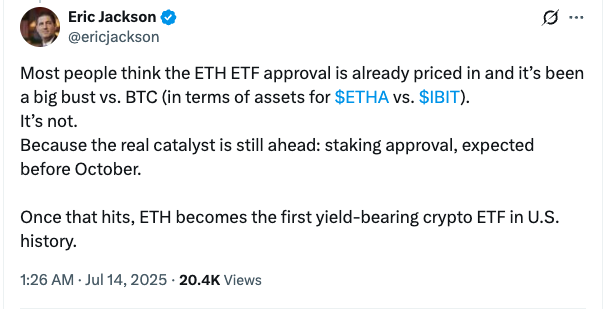
This Supercycle Will Redefine Crypto
Posted October 06, 2025
Chris Campbell
In the 1950s, dividends turned post-war stocks from speculation into retirement income and helped send the S&P up fivefold.
In the 1980s, double-digit Treasury yields drew global capital and launched a forty-year bond rally that defined modern finance.
In the 2000s, gold miners started paying dividends and were re-rated from dusty speculations to cash-flow machines.
The key insight…
When an asset starts paying (dividends, interest, buybacks), it stops being a toy for speculators and becomes a tool for allocators.
Right now…
We’re entering a similar era for crypto. One where digital assets aren’t just held in traditional brokerage-friendly products, they earn.
And just like in the ‘50s… the ‘80s… and the 2000s…
It’s going to have a HUGE impact on who shows up to buy. (And, indeed, prices will follow.)
ETFs Just Got an Upgrade
As of today, Grayscale—the biggest digital asset manager in the world—just turned Ethereum and Solana staking into a yield product.
And with Ethereum, it did it twice.
- $ETHE: The “cash-flow” version. It stakes Ethereum and pays out staking rewards as cash distributions right into your brokerage account.
- $ETH (the Mini Trust): The “compounder.” It stakes Ethereum too, but reinvests those rewards back into the fund, growing the NAV — and your exposure — automatically.
If you’re not familiar with staking, think of it this way…
When a company pays a dividend, it’s sharing profits from selling products. When Ethereum pays staking rewards, it’s sharing network fees to entities holding ETH and helping to keep the network running.
Different sources, same effect.
Both pay you for owning the asset and helping it work. Dividends come from business profits. Staking yield comes from entities locking up
Ethereum and helping to secure the network.
But to investors, they have the same effect: a steady stream of income that turns a “buy and hope” asset into a “buy and hold” one.
Why This Is a Big Deal
Money is already flooding into crypto ETFs—sometimes billions at a time.
BUT up until now, Ethereum ETFs were like display cases. They held ETH, but they couldn’t use it.
No staking, no yield, no compounding—just price exposure.
That’s over.
Starting now, ETF capital is going to participate in Ethereum’s economy.
And every single ETF will be doing the same thing: buying ETH on the open market and locking it up.
And it pulls in two types of important investors:
- Yield hunters (income funds, family offices, retirees) get a familiar payout model through $ETHE.
- Long-term believers and crypto-native funds get a compounding vehicle through $ETH.
Both translate into steady demand for Ethereum, less available supply.
The Ethereum Supercycle
Tom Lee of Fundstrat says we’re entering an Ethereum supercycle— where crypto, AI, and Wall Street fuse into one trillion-dollar feedback loop.
Eric Jackson of EMJ Capital pegs $10,000+ ETH as his base case this cycle. He bets that the market has not yet priced in the full effect of staking-enabled ETFs.

Token Metrics, FastBull, Brave New Coin — they’re all screaming the same number in different accents: five figures.
James and I agree.
And one of the BIGGEST catalysts, ETF staking—one we’ve been talking about since last year—just flipped.
It’s just one reason we think this supercycle will redefine crypto.
And this is just the beginning.
